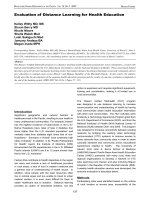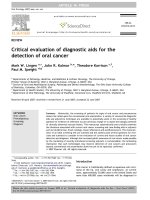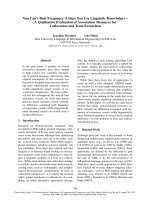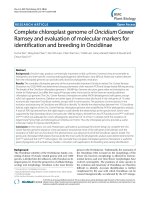Evaluation of spacing and nipping time under different sowing time in system of chickpea intensification for climate change adaptation
Bạn đang xem bản rút gọn của tài liệu. Xem và tải ngay bản đầy đủ của tài liệu tại đây (332.18 KB, 11 trang )
Int.J.Curr.Microbiol.App.Sci (2019) 8(9): 1858-1868
International Journal of Current Microbiology and Applied Sciences
ISSN: 2319-7706 Volume 8 Number 09 (2019)
Journal homepage:
Original Research Article
/>
Evaluation of Spacing and Nipping Time under different Sowing Time in
System of Chickpea Intensification for Climate Change Adaptation
H. L. Sonboir1*, Vivek Tripathi1, L. K. Shrivastava2 and Sonendra Kumar1
1
Department of Agronomy, India
Department of soil Science and Agricultural Chemistry, India
College of Agriculture, Indira Gandhi Krishi vishwavidyalaya, Raipur-492012, India
2
*Corresponding author
ABSTRACT
Keywords
Chickpea, Sowing
time, Nipping,
System of chickpea
intensification,
Nodulation, seed
yield, Economics,
Climate change
adaptation
Article Info
Accepted:
20 August 2019
Available Online:
10 September 2019
A field experiment was laid out to evaluate effect of spacing and nipping
time in different sowing time of chickpea at Agriculture Instructional cum
Research Farm, IGKV, Raipur, Chhattisgarh during two consecutive winter
seasons of 2016-17 and 2017-18 with four sowing time (First week of
November, Third week of November, First week of December and Third
week of December), three spacing (30x20, 40x20 and 50x20 cm) and three
nipping time (No nipping, Nipping at 30 days, Nipping at 40 days).
Nodulation and yield attributes were observed higher in November sowing
with 50x20cm and 40x20 cm spacing. Spacing of 50x20 cm recorded
higher seed yield (11.0 to 11.5%) and net return (24.2 to 24.7%) in first and
third week of November sowing, moreover, spacing of 30x20 cm recorded
higher seed yield (11.0 to 12.6%) and net return (21.9 to 23.1%) in third
week of December sowing. Nipping at 30-40 DAS recorded increase of 4.8
to 7.5% in seed yield and 3.8 to 8.3% in net return in November sowing,
however, it caused decrease of 9.3 to 12.2 % in seed yield and 30.7 to 37.5
% in net return in third week of December sowing.
Introduction
Pulses are the most important source of
protein in vegetarian diets. Looking into
dietary essentiality of pulses, United nations
declared 2016 as the International Year of
Pulses. Chickpea is an important winter
season pulse crop in India with 8.40 million
hectare area and total production of 7.06
million metric tonnes during 2015-16 (Annual
report, 2016-17). Chickpea is the most
important crop grown during winter season in
Chhattisgarh plain agro-climatic zone of India.
It occupies 0.37 million ha with productivity
of 1100 kg/ha (Krishi Darshika, 2018). The
low productivity of chickpea is mainly due to
1858
Int.J.Curr.Microbiol.App.Sci (2019) 8(9): 1858-1868
change in climatic condition, enhanced pest
attack
and
improper
agro-techniques
particularly under climate change scenario.
As per projection, India will begin to
experience more seasonal variation in
temperature with more warming in the winter
season (Kumar and Gautam, 2014) and an
increase of average temperature of 10C can
decrease yield of major food crops by 3.17.4% (Zhao et al., 2017). Due to change in
climatic condition winter season, chickpea is
not performing well under the current
recommended package of practices and
shorter winter period exposes the chickpea
crop often to hot condition during pod
formation and grain filling stage. Hatfield and
Prueger (2015) reported that warm
temperature increased the rate of senescence
during grain filling stage and reduced final
grain yield.
There are several reports suggesting
adaptation strategies to reduce ill effect of
climate change such as, adjustment of planting
dates, variety, crop relocation, improved land
management, etc.
System of chickpea intensification has been
reported to produce higher seed yield of
chickpea compared to conventional sowing
method recently (Sonboir and Tripathi, 2018,
2019) which is attributed with wider spacing
and nipping practice. However, spacing and
nipping practice can affect the chickpea crop
in differently in varying sowing time as in
changed climatic condition, the late sown
crops has lesser biomass due to short winter
period and exposure to heat during terminal
stages. Therefore, a study was undertaken to
know the effect of spacing and nipping time
under varying sowing time in nodulation,
yield and economic feasibility of chickpea
under irrigated condition and to develop
climate change adaptation strategies for
chickpea.
Materials and Methods
A field experiment was conducted at
Agriculture Instructional cum Research farm,
IGK Raipur during two consecutive winter
seasons of 2016-17 and 2017-18. The soil was
clay in texture (Vertisols), neutral in soil
reaction (pH 7.1), normal in electrical
conductivity (0.16 dS/m), low in available
nitrogen (219.7 kg/ha), medium in available
phosphorus (13.9 kg/ha) and high in
potassium (365.1 kg/ha). The experiment was
laid out in split-split plot design with three
replications. Main plot treatment consisted of
four sowing time, viz. First week of
November, third week of November, first
week of December and third week of
December, sub-plot treatments had three
levels of spacing, viz. 30x20 cm, 40x20 cm
and 50x20 cm and sub-sub plot treatments had
three nipping time viz. No nipping, nipping at
30 days and nipping at 40 days. The test
variety was JG 130. The chickpea crop was
fertilized with 20:50:30 kg NP2O5:K2O/ha at
basal. The irrigation was given thrice, first just
after sowing to ensure germination with 5cm
irrigation water and subsequent irrigation at 30
days and 50 days after sowing with 4cm of
irrigation water. The field were kept weed free
through mechanical weeding at 20 and 40
days. The crop received 0.8 and 16.4 mm of
rains during 2016-17 and 2017-18,
respectively. During 2016-17, the winter
season maximum temperature rising from 1st
week of February. Moreover, during 2017-18,
maximum temperature started rising from 3rd
week of February. The number and dry weight
of nodules were recorded at pre-flowering
stage by destructive plant sampling with
proper care. The seed and straw yield were
recorded from net plot area after removing the
border area. The gross return, cost of
cultivation and net return were calculated from
market price of the different inputs and
outputs. B:C ratio was calculated by dividing
gross return to cost of cultivation. All the data
1859
Int.J.Curr.Microbiol.App.Sci (2019) 8(9): 1858-1868
were subjected to analysis of variance as
suggested by Gomez and Gomez (1983) for
proper inference of results.
Results and Discussion
Number and dry weight of nodules/plant
Number and dry weight of nodules were
significantly influenced by sowing time,
spacing and nipping time (Table 1). Third
week of November sowing exhibited
maximum number of nodules per plant and
nodule dry weight, which was however
statistically similar to first week of November
sowing. December sown chickpea crop
showed decrease in nodules and nodule dry
weight/plant. The lowest number and dry
weight of nodules were recorded in third week
of December sowing with significant
difference to others. Similar report is also
observed by Thalji and Shalaldeh (2006).
Regarding spacing, 50x20 cm recorded more
number and dry weight of nodules per plant
which was however statistically at par with
spacing of 40x20 cm. Closer spacing of 30x20
cm exhibited the lowest number and dry
weight of nodules. Nipping time did not exert
any significant difference in number and dry
weight of nodules per plant.
Yield attributes
Number of pods/plant, number of seeds/pod
and seed index were significantly influenced
by sowing time, spacing and nipping time.
Among all these yield attributes, only number
of pods/plant differed significantly due to
differences in sowing time.
Third week of November sowing exhibited
significantly higher number of pods/plant,
number of seeds/pod and seed index,
statistically at par with first week of
November sowing (Table 2). December sown
chickpea crop showed decrease in number of
pods/plant, seeds/pod and seed index. The
lowest number of pods/plant, number of
seeds/pod and seed index were recorded in
third week of December sowing with
significant difference to others. Spacing of
50x20 cm spacing produced more number of
pods/plant in all the sowing time with
significant difference; however, it was par
with 40x20 cm spacing in first week of
December sowing. Wider spacing of 50x20
cm spacing produced 29.8 to 31.7% more
number of pods /plant as compared to closer
spacing of 30x20 cm in November sowing of
chickpea. Increase in number of pods/plant
with increase in row spacing is also reported
by Sonboir et al., (2017). Third week of
December sowing did not exert any significant
difference in number of pods due to spacing
(Table 3).
Nipping exerted significant contribution only
in number of pods/plant in first and third week
of November sowing and the maximum
number of pods/plant was recorded with
nipping at 40 days however it was at with
nipping at 30 days.
Nipping recorded 15.3 to 21.2% increase in
number of pods/plant in November sowing of
chickpea. December first week sowing did not
exhibited any significant difference in number
of pods/plant while third week of December
sowing recorded decrease in number of
pods/plant due to nipping and the decrease
was to the tune of 7.0 to 8.2%. (Table 4)
Seed yield, straw yield and harvest index
Seed yield, straw yield and harvest index were
significantly influenced by sowing time,
spacing and nipping time moreover,
interaction effect of sowing time with spacing
and nipping time were found significant. The
variation in yield level was also observed in
both years of study and the lower yield
obtained during 2016-17 may be due to
shorter winter period.
1860
Int.J.Curr.Microbiol.App.Sci (2019) 8(9): 1858-1868
First week of November sowing exhibited
significantly higher seed yield, straw yield and
harvest index, statistically at par with third
week of November sowing (Table 5).
December sown chickpea crop showed
decrease in seed yield, straw yield and harvest
index. The lowest seed yield, straw yield and
harvest index were recorded in third week of
December sowing with significant difference
to others. The lower yield in late sown crop
may be due heat stress during reproductive
development (Devasirvatham et al., 2012).
The maximum seed and straw was recorded
with 50x20 cm spacing in first and third week
of November sowing however it was
statistically par with 40x20 cm spacing in
third week of November sowing. The average
increase in seed yield was recorded 11.0 to
11.5 % under 50x20 cm spacing compared to
closer spacing of 30x20 cm in November
sowing time. Higher yield under wider
spacing in early sown crop may be due to
better expression of growth parameters and
availability of sufficient time to mature crop
within desired temperature range. Similar
result is also reported by Mondal (2000).
Spacing of 40x20 cm recorded maximum seed
and straw yield in first week of December
sowing time which was statistically at par with
30x20 cm spacing. In third week of December
sowing time, closer spacing of 30x20 cm
recorded maximum seed and straw yield with
significant difference and the decreased the
average seed yield to the tune of 11.0 to
12.6% due to increase in spacing (Table 6).
Nipping time exhibited significant effect on
seed and straw yield in different sowing time
(Table 7). The maximum seed yield was
recorded in nipping at 40 days which was
however statistically similar to nipping at 30
days in first and third week of November
sowing time. Yield enhancement with nipping
of terminal buds in chickpea is also reported
by Baloch and Zubair (2010). The average
increase in seed yield was 4.8 to 7.5% over no
nipping in November sowing of chickpea.
Nipping did not exhibit seed yield
enhancement in December first week sowing
time, however, higher straw yield was
recorded under nipping at 30 days. No nipping
recorded maximum seed and straw yield in
third week of December sowing. Nipping
caused 9.3 to 12.2 % and decrease in seed
yield over no nipping. The reduction in seed
yield of chickpea with progressive delay in
sowing beyond 10th December is also reported
by Shrivastava et al., (1990).
Gross return, net return and B:C ratio
Gross return, net return and B:C ratio were
significantly influenced by sowing time,
spacing and nipping time moreover,
interaction effect of sowing time with spacing
and nipping time were found significant.
First week of November sowing recorded
significantly higher gross return, net return
and B:C ratio followed by third week of
November sowing (Table 8).
December sown chickpea crop showed more
decrease in gross return, net return and B:C
ratio. The lowest gross return, net return and
B:C ratio were recorded in third week of
December sowing with significant difference.
50x20 cm spacing recorded higher gross
return, net return and B:C ratio in first and
third week of November sowing. The average
increase in net return was recorded 24.2 to
24.7 % under 50x20 cm spacing compared to
closer spacing of 30x20 cm in November
sowing time. Spacing of 40x20 cm recorded
maximum gross, net return and BC ratio in
first week of December sowing time which
was statistically at par with 30x20 cm spacing.
Closer spacing of 30x20 cm recorded
maximum gross return, net return and B:C
ratio in third week of December sowing time
with significant difference.
1861
Int.J.Curr.Microbiol.App.Sci (2019) 8(9): 1858-1868
The average decrease in net return was to the
tune of 21.9 to 23.1% due to increase in
spacing in third week of December sowing
(Table 9).
Table.1 Number and dry weight of nodules at pre-flowering stage of chickpea as influenced by
sowing time, spacing and nipping under SCI.
Treatments
Sowing time
Nov. 1st week
Nov. 3rd week
Dec. 1st week
Dec.3rd week
CD (p=0.05)
Spacing
30x20 cm
40x20 cm
50x20 cm
CD (p=0.05)
Nipping time
No nipping
Nipping at 30 DAS
Nipping at 40 DAS
CD (p=0.05)
Number of nodules/plant
2016
2017
Mean
Dry weight of nodules/plant, g
2016
2017
Mean
34.3
45.9
29.0
21.9
1.46
57.4
48.3
32.5
24.1
1.8
45.9
47.1
30.8
23.0
1.7
0.57
0.72
0.47
0.38
0.06
0.78
0.69
0.53
0.42
0.08
0.68
0.71
0.50
0.40
0.07
31.8
32.6
34.0
1.4
39.5
40.7
41.6
1.6
35.7
36.7
37.8
1.5
0.51
0.53
0.56
0.02
0.75
0.79
0.82
0.03
0.63
0.66
0.69
0.03
32.0
32.8
33.5
1.2
40.3
40.6
40.8
NS
36.2
36.7
37.2
NS
0.52
0.53
0.55
0.02
0.75
0.77
0.78
NS
0.64
0.65
0.67
NS
Table.2 Yield attributes of chickpea as influenced by sowing time, spacing and nipping under
SCI.
Treatments
Sowing time
Nov. 1st week
Nov. 3rd week
Dec. 1st week
Dec.3rd week
CD (p=0.05)
Spacing
30x20 cm
40x20 cm
50x20 cm
CD (p=0.05)
Nipping time
No nipping
Nipping at 30 DAS
Nipping at 40 DAS
CD (p=0.05)
Number of
pods/plant
2016 2017 Mean
Number of seeds/pod
Seed index, g
2016
2017
Mean
2016
2017
Mean
76.3
83.5
57.0
44.5
2.4
91.7
85.4
60.2
47.9
4.6
84.0
84.4
58.6
46.2
3.5
1.73
1.75
1.62
1.48
0.04
1.76
1.73
1.64
1.52
0.06
1.75
1.74
1.63
1.50
0.05
22.35
24.01
20.25
18.47
0.63
28.45
27.64
26.52
24.53
0.84
25.40
25.83
23.39
21.50
0.74
56.7
65.1
74.1
2.0
66.3
72.1
75.4
1.8
61.5
68.6
74.8
1.9
1.62
1.65
1.66
NS
1.64
1.66
1.67
NS
0.05
1.63
1.66
NS
20.96
21.40
21.45
0.32
26.54
26.76
27.06
0.42
23.75
24.08
24.26
0.37
62.5
66.7
66.8
1.6
68.2
72.5
73.3
1.5
65.4
69.6
70.0
1.6
1.62
1.64
1.67
0.04
1.65
1.66
1.66
NS
1.64
1.65
1.67
NS
20.98
21.32
21.50
0.30
26.75
26.87
26.76
NS
23.87
24.10
24.13
NS
1862
Int.J.Curr.Microbiol.App.Sci (2019) 8(9): 1858-1868
Table.3 Number of pods/plant of chickpea as influenced by interaction effect of sowing time and
spacing under SCI.
Treatments
st
Nov. 1 week
Nov. 3rd week
Dec. 1st week
Dec.3rd week
CD (p=0.05)
Number of pods/plant
30x20 cm
40x20cm
2016
2017
Mean
2016
2017
64.0
80.5
72.3
74.0
95.1
68.2
78.7
73.5
83.6
85.3
52.68
58.3
55.5
58.0
59.9
41.71
47.5
44.6
45.0
47.9
Spacing at same sowing time
Sowing time at same spacing
Mean
84.6
84.5
59.0
46.5
50x20 cm
2016
2017
90.9
99.5
98.6
92.1
60.4
62.3
46.8
48.2
4.1
5.4
4.1
5.1
Mean
95.2
95.4
61.4
47.5
4.8
4.6
Table.4 Number of pods/plant of chickpea as influenced by interaction effect of sowing time and
nipping under SCI.
Treatments
Nov. 1st week
Nov. 3rd week
Dec. 1st week
Dec.3rd week
CD (p=0.05)
Number of pods/plant
No nipping
Nipping at 30 DAS
2016
2017 Mean
2016 2017
Mean
68.6
80.3 74.5
79.5
95.1
87.3
73.5
79.0 76.3
87.8
88.1
88.0
60.5
63.4 62.0
56.1
59.8
58.0
47.4
50.0 48.7
43.4
47.1
45.3
Nipping at same sowing time
Sowing time at same nipping
Nipping at 40 DAS
2016
2017
Mean
80.8
99.7
90.3
89.1
89.1
89.1
54.5
57.4
56.0
42.7
46.6
44.7
3.2
4.8
4.0
3.5
4.3
3.9
Table.5 Seed yield of chickpea as influenced by sowing time, spacing and nipping under SCI.
Treatments
Sowing time
Nov. 1st week
Nov. 3rd week
Dec. 1st week
Dec.3rd week
CD (p=0.05)
Spacing
30x20 cm
40x20 cm
50x20 cm
CD (p=0.05)
Nipping time
No nipping
Nipping at 30 DAS
Nipping at 40 DAS
CD (p=0.05)
Seed yield, kg/ha
2016
2017
Mean
Straw yield, kg/ha
2016
2017
Mean
Harvest index
2016
2017
Mean
2226
2349
1827
1411
93
2889
2573
2099
1590
129
2558
2461
1963
1501
111
3897
4118
3460
2932
78
4285
3810
3318
2871
93
4091
3964
3389
2902
86
36.33
36.31
34.56
32.53
1.44
40.27
40.31
38.76
35.65
1.86
38.30
38.31
36.66
34.09
1.65
1903
1978
1980
51
2276
2296
2292
NS
2090
2137
2136
NS
3605
3604
3596
NS
3593
3599
3520
NS
3599
3602
3558
NS
34.43
35.16
35.20
NS
38.78
38.94
39.43
NS
36.61
37.05
37.32
NS
1921
1993
1947
30
2271
2293
2299
NS
2096
2143
2123
NS
3539
3651
3614
52
3581
3557
3575
58
3560
3604
3595
55
35.03
35.06
34.71
NS
38.81
39.20
39.15
1.02
36.92
37.13
36.93
NS
1863
Int.J.Curr.Microbiol.App.Sci (2019) 8(9): 1858-1868
Table.6 Seed and straw yield of chickpea as influenced by interaction effect of sowing time and
spacing under SCI.
Treatments
Nov. 1st week
Nov. 3rd week
Dec. 1st week
Dec.3rd week
CD (p=0.05)
Nov. 1st week
Nov. 3rd week
Dec. 1st week
Dec. 3rd week
CD (p=0.05)
30x20 cm
40x20cm
2016
2017 Mean 2016
2017
Seed yield, kg/ha
2077
2787 2432
2260
2801
2159
2458 2309
2428
2595
1834
2142 1988
1855
2258
1541
1718 1630
1370
1529
Spacing at same sowing time
Sowing time at same spacing
Straw yield, kg/ha
3723
4186 3955
3909
4325
3973
3739 3856
4129
3766
3462
3359 3411
3550
3509
3262
3087 3175
2827
2797
Spacing at same sowing time
Sowing time at same spacing
50x20 cm
2017
Mean
Mean
2016
2531
2512
2057
1450
2342
2460
1794
1324
103
124
3079
2666
1898
1524
160
183
2711
2563
1846
1424
132
154
4117
3948
3530
2812
4060
4251
3366
2706
152
146
4344
3925
3084
2728
165
154
4202
4088
3225
2717
159
150
Table.7 Seed and straw yield of chickpea as influenced by interaction effect of sowing time and
nipping under SCI.
Treatments
Nov. 1st week
Nov. 3rd week
Dec. 1st week
Dec.3rd week
CD (p=0.05)
Nov. 1st week
Nov. 3rd week
Dec. 1st week
Dec.3rd week
CD (p=0.05)
No nipping
Nipping at 30 DAS
2016 2017 Mean 2016 2017 Mean
Seed yield, kg/ha
2119 2793 2456 2262 2909 2586
2251 2476 2364 2387 2569 2478
1812 2081 1947 1937 2148 2043
1501 1733 1617 1386 1546 1466
Nipping at same sowing time
Sowing time at same nipping
Straw yield, kg/ha
3742 4227 3985 3943 4278 4111
3931 3769 3850 4190 3741 3966
3409 3302 3356 3570 3394 3482
3539 3024 3282 3400 2815 3108
Nipping at same sowing time
Sowing time at same nipping
1864
Nipping at 40 DAS
2016
2017 Mean
2299
2410
1732
1347
60
104
2964
2673
2069
1492
120
161
2632
2542
1901
1420
90
133
4007
4232
3400
2818
104
115
4349
3920
3257
2773
134
119
4178
4076
3329
2796
119
117
Int.J.Curr.Microbiol.App.Sci (2019) 8(9): 1858-1868
Table.8 Economics of chickpea as influenced by sowing time, spacing and nipping under SCI
Treatment
2016
Sowing time
Nov. 1st week
Nov. 3rd week
Dec. 1st week
Dec.3rd week
CD (p=0.05)
Spacing
30x20 cm
40x20 cm
50x20 cm
CD (p=0.05)
Nipping time
No nipping
Nipping at 30 DAS
Nipping at 40 DAS
CD (p=0.05)
Gross return, Rs/ha
2017
Mean
Net return, Rs/ha
2016
2017
Mean
2016
B:C ratio
2017
Mean
89059
93972
73094
56459
3680
124913
111249
90887
69028
4765
106986
102611
81991
62744
4223
52023
56935
36057
19422
3680
80500
66836
46474
24615
4765
66262
61886
41266
22019
4223
2.41
2.54
1.98
1.53
0.10
2.82
2.51
2.05
1.56
0.13
2.62
2.53
2.02
1.55
0.12
76107
79128
79203
2058
98531
99368
99160
NS
87319
89248
89182
1045
37731
42137
43460
2058
52532
55010
56278
NS
45132
48574
49869
1045
1.98
2.14
2.22
0.06
2.14
2.24
2.31
0.07
2.06
2.19
2.27
0.07
76834
79717
77888
1193
98306
99238
99514
1134
87570
89478
88701
1164
41164
41997
40168
1193
55766
53888
54165
1134
48465
47943
47167
1164
2.16
2.12
2.07
0.03
2.31
2.19
2.20
0.04
2.24
2.16
2.14
0.04
Table.9 Economics of chickpea as influenced by interaction effect of
sowing time and spacing under SCI
Treatments
40x20cm
Mean
2016
2017
Mean
Gross return, kg/ha
83082
120527
101805
90406
121198
105802
86377
106316
96347
97129
112158
104644
73349
92721
83035
74183
97733
85958
61622
74558
68090
54792
66383
60588
Spacing at same sowing time
Sowing time at same spacing
Net return, kg/ha
44705
74528
59617
53416
76840
65128
48000
60317
54159
60138
67799
63969
34972
46722
40847
37193
53375
45284
23245
28560
25903
17801
22025
19913
Spacing at same sowing time
Sowing time at same spacing
B:C ratio
2.16
2.62
2.39
2.44
2.73
2.59
2.25
2.31
2.28
2.63
2.53
2.58
1.91
2.02
1.97
2.01
2.20
2.11
1.61
1.63
1.62
1.48
1.50
1.49
Spacing at same sowing time
Sowing time at same spacing
2016
Nov. 1st week
Nov. 3rd week
Dec. 1st week
Dec.3rd week
CD (p=0.05)
Nov. 1st week
Nov. 3rd week
Dec. 1st week
Dec.3rd week
CD (p=0.05)
Nov. 1st week
Nov. 3rd week
Dec. 1st week
Dec.3rd week
CD (p=0.05)
30x20 cm
2017
1865
2016
50x20 cm
2017
Mean
93690
98411
71749
52963
4115
4971
133014
115275
82207
66143
5321
6124
113352
106843
76978
59553
4718
5548
57947
62668
36006
17220
4115
4971
90132
72393
39325
23261
5321
6124
74040
67531
37666
20241
4718
5548
2.62
2.75
2.01
1.49
0.11
0.14
3.10
2.69
1.92
1.55
0.14
0.19
2.86
2.72
1.97
1.52
0.13
0.17
Int.J.Curr.Microbiol.App.Sci (2019) 8(9): 1858-1868
Table.10 Economics of chickpea as influenced by interaction effect
of sowing time and nipping under SCI
Treatments
Nov. 1st week
Nov. 3rd week
Dec. 1st week
Dec.3rd week
CD (p=0.05)
Nov. 1st week
Nov. 3rd week
Dec. 1st week
Dec.3rd week
CD (p=0.05)
Nov. 1st week
Nov. 3rd week
Dec. 1st week
Dec.3rd week
CD (p=0.05)
No nipping
Nipping at 30 DAS
2016
2017
Mean 2016
2017
Mean
Gross return, Rs/ha
84748 120836 102792 90475 125759 108117
90041 107136 98589 95470 111072 103271
72492 90104 81298 77497 93001 85249
60055 75150 67603 55424 67120 61272
Nipping at same sowing time
Sowing time at same nipping
Net return, Rs/ha
49078 78296 63687 52755 80409 66582
54371 64596 59484 57750 65722 61736
36822 47564 42193 39777 47651 43714
24385 32610 28498 17704 21771 19738
Nipping at same sowing time
Sowing time at same nipping
B:C ratio
2.38
2.85
2.62
2.40
2.78
2.59
2.53
2.52
2.53
2.54
2.45
2.50
2.03
2.12
2.08
2.06
2.05
2.06
1.68
1.77
1.73
1.47
1.48
1.48
Nipping at same sowing time
Sowing time at same nipping
Nipping time exhibited significant effect on
gross return, net return and B: ratio in
different sowing time (Table 10). The
maximum gross return and net return was
recorded in nipping at 40 days which was
however statistically similar to nipping at 30
days in first and third week of November
sowing time.
The average increase in net return was 3.8 to
8.3% over no nipping in November sowing of
chickpea. Nipping at 30 days recorded
maximum gross return and net return in first
week of November sowing, moreover, net
return was at par with no nipping in first week
of November sowing. No nipping recorded
maximum gross return and net return in third
week of December sowing. Nipping caused
Nipping at 40 DAS
2016
2017
Mean
91954 128145 110050
96406 115541 105974
69293 89557 79425
53897 64815 59356
2385
3576
2981
4149
4895
4522
54234
58686
31573
16177
2385
4149
82795
70191
44207
19465
3576
4895
68515
64439
37890
17821
2981
4522
2.44
2.56
1.84
1.43
0.07
0.11
2.83
2.55
1.97
1.43
0.08
0.14
2.64
2.56
1.91
1.43
0.08
0.13
30.7 to 37.5 % decrease in net return over no
nipping. B: ratio was recorded higher in first
and third week of November sowing. Spacing
and nipping time exerted significant difference
in different sowing time. The maximum yield
attributes, seed yield, straw yield, gross return
and net return were recorded with 50x20 cm
spacing and nipping at 40 days which was
however statistically similar to nipping at 30
days in first and third week of November
sowing. No nipping recorded maximum seed
yield, straw yield, gross return and net return
in third week of December sowing. Thus, in
changing climate scenario, wider spacing with
nipping operation at 30-40 days for higher
yield and net return in early sown crop in the
month of November and closer spacing of
30x20 cm spacing without nipping operation
1866
Int.J.Curr.Microbiol.App.Sci (2019) 8(9): 1858-1868
in delayed sowing of third week of December
can be practiced to minimize the losses in seed
yield and net return of chickpea.
References
Annual
report 2016-17. Department of
Agriculture, Cooperation and Farmers
welfare,
Directorate
of
pulse
development Vindhyachal Bhavan,
Govt of India, p 9
Baloch, M. S. and Zubair, M. 2010. Effect of
nipping on growth and yield of
chickpea. The Journal of Animal &
Plant Sciences, 20(3): 208-210
Devasirvatham, V., Tan, D. K. Y., Gaur, P.
M., Raju, T. N., Trethowan, R. M.
2012. High temperature tolerance in
chickpea and its implications for plant
improvement. Crop and Pasture
Science, 63(5):419-428
Gomez, K. A. and Gomez, A. A. 1983.
Statistical procedures for agricultural
research. An International Rice
Research Institute book, John Wiley
and Sons, New York.
Hatfield, J. L. and Prueger, J. H. 2015.
Temperature extremes: effect on plant
growth and development. Weather and
climate extremes, 10 (A) page 4-10.
Krishi darshika, 2018. Area and productivity
of different crops in Chhattisgarh.
Krishi Darshika Published by Indira
Gandhi
Krishi
Vishwavidyalaya,
Raipur PP 6.
Kumar, R. and Gautam, H. R. 2014. Climate
Change and its Impact on Agricultural
Productivity in India Journal of
Climatology & Weather Forecasting 2
(1): 1000109.
Mondal, S. 2000. Response of chickpea
varieties (Cicer arietinum L.) to dats of
sowing and row spacing under late
sown condition. M.Sc. (Agronomy)
thesis submitted to G.B. Pant
University
of
Agriculture
and
Technology, Pantanagar, India.
Shrivastava, S. K., Singh, R. and
Chandrawanshi, B. R. 1990. Response
of chickpea cultivars under different
dates of sowing in Chhattisgarh region
of Madhya Pradesh. International
Chickpea news letter, 23: 26-27.
Sonboir, H. L., Sahu, B.K. and Vivek Tripathi.
2017. Evaluation of row spacing and
nipping
on
productivity
and
profitability of chickpea under
irrigated condition. Green Farming
8(2): 422-425.
Sonboir, H. L. and Vivek Tripathi. 2018.
System of chickpea intensification-A
new initiative to enhance productivity
of irrigated chickpea. Newsletter, India
society of Agronomy, ICAR-IARI,
New Delhi, April to September Vol 2
(2&3):5-6
Sonboir, H. L. and Vivek Tripathi. 2019. An
innovative approach to enhance
chickpea productivity under irrigated
condition-system
of
chickpea
intensification.
Institutional
innovations
and
interventions,
Management practices for crops and
allied enterprises published by Indira
Gandhi
Agriculture
University
technical cell, Volume I: 1-5
Thalji, T. and Shalaldeh, G. 2006. Effect of
planting date on Faba bean (Vicia faba
L.) nodulation and performance under
semiarid conditions. World Journal of
Agricultural Sciences, 2(4): 477-482.
Zhao, C., Liu, B., Piao, S. and Wang, H. 2017.
Temperature increase reduces global
yields of major crops in four
independent estimates. In Proceeding
of the national academy of sciences
114 (35) 9326-9331.
1867
Int.J.Curr.Microbiol.App.Sci (2019) 8(9): 1858-1868
How to cite this article:
Sonboir H. L., Vivek Tripathi, L. K. Shrivastava and Sonendra Kumar 2019. Evaluation of
Spacing and Nipping Time under different Sowing Time in System of Chickpea Intensification
for Climate Change Adaptation. Int.J.Curr.Microbiol.App.Sci. 8(09): 1858-1868
doi: />
1868









